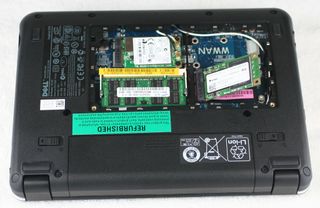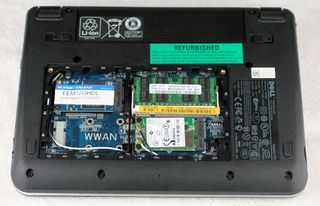How-To: Upgrade Your Netbook, Easily
Pep up your dumbed-down netbook with these easy projects: upgrade RAM, get a bigger hard disk, and add SD flash memory. Trust us, this is easy.
Upgrading the Dell Mini 9 SSD
Our Dell unit came from the Outlet equipped with an 8 GB STEC mini-PCIe solid state drive (SSD). Some units, especially those designed for use with Linux rather than Windows XP, even ship with only 4 GB SSDs, while Dell equips others with 16 GB. Aftermarket upgrades of up to 128 GB are readily available and usually cost between $2.50 or so per GB of storage ($330 for a double-wide 128 GB model) and $3.20 or so per GB ($50 for a 16 GB model). Switching out an old SSD for a new one in the Dell Mini 9 is trivially easy—it’s very much like swapping a memory module as described in the preceding section. But before you can undertake such an action, there’s some very important work to do first.
Create an image of the old drive to transfer to the new one
Whether you use a commercial program like Norton Ghost or Acronis TrueImage or a freeware offering such as the DriveImage XML Backup software, you must burn an image of your current drive before you can even think about removing an existing SSD. The drill works something like this:
- Make an image of the existing drive and create a bootable UFD, CD, or DVD from which you can restore that image to another drive
- Swap out the old SSD for the new SSD
- Boot your system from your bootable UFD, CD, or DVD, then restore the image from the old drive onto the new one
Unless you know how to build a bootable UFD that includes your chosen backup utility’s restore program, the easiest way to do this is to use a USB-attached DVD burner along with an external USB-attached hard disk. You’ll use your backup program to write the image from the old SSD to the external hard disk, and then burn yourself an optical disc that knows how to find that external hard drive to restore the image backup it contains. Alas, if you can’t beg or borrow a USB-attached DVD burner, you’ll have to buy one (expect to pay $50 to $70 for such a device, and don’t forget to buy some blank DVDs).
Swapping out the Mini 9 SSD
After all that preparation, the actual swap is incredibly easy. Here’s how:
- Remove the machine screw that holds the SSD down level with the motherboard. It’s in the upper right or left corner of the device on the opposite edge from the mini-PCIe slot.

Remove the old SSD and seat the new one (like the SO-DIMM module, it has an off-center notch to prevent you from inserting it upside down). Slide it all the way in the slot, then press gently down on the far edge until the module is flush with its mounts. Replace the screw and tighten it until it’s snug.
Sign up to get the BEST of Tom’s Guide direct to your inbox.
Upgrade your life with a daily dose of the biggest tech news, lifestyle hacks and our curated analysis. Be the first to know about cutting-edge gadgets and the hottest deals.

- After you reboot your Mini 9, you’ll need to change the boot order in the BIOS to boot from your UFD or external optical drive. Then, plug in your external HD with the backup and restore the drive image from the old drive to the new one.
That’s it, you’re done. Surprisingly, our performance testing using HD Tach showed us data read rates of only 35-40 MB/s (average 36.5 MB/s) for the SuperTalent 32 GB drive, while we observed read rates slightly more than twice as fast at 70-76 MB/s (average 73.6 MB/s) for the 8 GB STEC. This tells us you’ll want to seek out the fastest possible Mini 9 SSDs if you want to make a replacement. Here’s another thought: keep the current SSD and spend $80 on a 30 GB Class 6 SDHC card. The Tom’s Hardware SDHC Memory Card Charts show average read speeds at just under 20 MB/s and average write speeds from 15-17 MB/s for Class 6 SDHC devices. It may be a better move to leave your Mini 9’s SSD alone and to augment it with a sizable and fast SDHC card instead.
Current page: Upgrading the Dell Mini 9 SSD
Prev Page Memory Upgrades Next Page Swapping Out the Asus Eee PC 1000HE Hard Drive-
jlee0585 ActiveMP made a similar set of tutorials as videos for the EeePC and the Mini 9. You might want to check it out.Reply
Here are the links:
http://www.youtube.com/watch?v=0TciyrKjLfU (EeePC)
http://www.youtube.com/watch?v=ARz6GbQnCwg (Mini 9)
Btw, you might want to remove the batteries before you remove and replace any internal parts. Just to be safe. ActiveMP also sells SSD replacements so you might want to check them out. -
mikestech I upgraded my Dell Mini 9 from the stock 8GB SSD to the 64GB Runcore SSD. I noticed a significant performance improvement. It's amazing what this little machine can do with a fast SSD and 2GB of RAM. I even occassionaly use it for video editing in Sony Vegas 9.Reply
Mike
http://solidstatedrivehome.com
-
I recently upgraded the hard disk in my Toshiba Satellite pro that had a 60 GB hard drive, with a Seagate 320GB 7200.3 drive. The disk cloning process I did using the DOS version of Seagates Seatools. In all I managed to complete the cloning and disk changeover in 40 minutes. It runs like a dream and is detectably faster in operation.Reply
Seatools is free, fast, small and relatively simple to use with a nice GUI in DOS. I have to admit I have tweaked the basic DOS configuration to recognise USB drives. -
mr_tuel Total cost of a netbook plus upgrades is > buying a full size laptop that is more powerful to begin with.Reply -
Well, mr_tuel, if you want to lug around 5 or 6 lbs with an optical drive you rarely use, feel free to carry your large, awkward full-size laptop. Size, portability and low weight are why these little beauties are such hot sellers. I just bought a 1000HE and love it.Reply
-
Luscious 2GB ram upgrades are a no-brainer at $25. I'm anticipating Win7 will replace XP as the de-facto Windows OS for netbooks.Reply
Not all netbooks come with 2.5" drives, and finding replacements for 1.8" models or units that use proprietary connectors/cradles will create trouble. Not all netbook hard drives are as easy to get to either.
Bumping up storage and ram won't do much though if you need more performance or a higher-res display. I was lucky to grab a HP 2133 last year that's still working well for me, but I'm eager to trade up to a Pinetrail unit as soon as Intel gets its act together. -
jn77 Ok, so I have had a Toshiba NB-205 for about 4 weeks now and I have upgraded it to 2gb, a 500gb 7200rpm drive, and Windows 7 RC. ( I understand that these are not suppose to be "Notebooks") but I want to know if there is any way to get around the 2gb ram limit.Reply
Is it a bios update, is it tied to the hardware, what will happen if I get a 4gb module to put in the netbook? -
michaelahess I've got a Mini 9 with the same 32GB SDD you guys used. Also have a touchscreen, gps, 8GB SD card, and an internal 4GB microSD card/reader. I use OS X almost exclusively for it and it works wonderfully. The stock 4GB SSD sucked and would pause at random. i've had no issues with speed on this guy. Best most usable laptop I've ever had. I always bring my normal laptop with but hardly ever use it except for work.Reply -
etittel Thanks for all the great comments and pointers. As for 4 GB in the netbooks, everything I've researched seems to indicate that Intel limits RAM to 2 GB as part of the Atom chipset/motherboard design specs. That said, I'm buying a couple of 4 GB SO-DIMMs for another machine of mine and will definitely pop one into either or both of these netbooks to see what happens. If they work or not, either way I'll report back here.Reply
As for the Aspire omission: I purchased both of these netbooks with my own hard-earned cash. The chancellor of the exchequer--my wife, that is--forbade me to purchase a 3rd netbook for cost reasons. If you want to loan me your Aspire, I'll gladly make the upgrades and photograph them, then return it to you exactly as it was sent to me (and cover shipping both ways). I wanted to get one of those, and a Samsung, and a ..., but "you can't always get what you want."
Thanks again to one and all,
--Ed--
